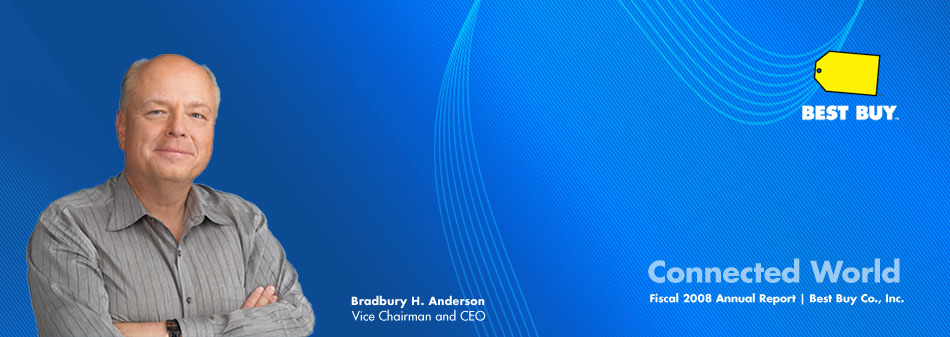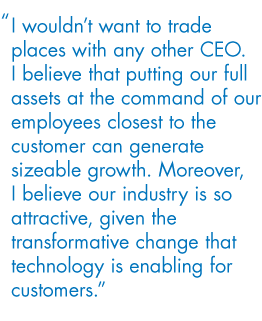

To our shareholders
Best Buy made great progress on the core challenges we undertook at the beginning of fiscal 2008, as we continue our customer centricity journey. We extended new and improved offerings to the consumer with the launch of Best Buy Mobile, the Apple store-within-a-store roll-out and the addition of Dell computers, to name a few. We improved the level of employee engagement and significantly reduced turnover among store employees. Customer satisfaction also rose. These improvements contributed to an increase in our market share to nearly 21 percent in the United States and more than 35 percent in Canada, where our Best Buy and Future Shop stores offer the consumer a choice of brands. We also saw continued strong consumer response to our stores in China, which together with our success in Canada gives us further optimism that our international expansion provides a huge runway for future growth.
Our financial performance also saw improvements. Diluted earnings per share rose to $3.12 in fiscal 2008, up 12 percent from $2.79 the prior year. Our EPS growth was driven primarily by the lower average number of shares outstanding, resulting from $3.5 billion of share repurchases in fiscal 2008. Our results also reflected an 11-percent rise in revenue, to $40 billion—a major milestone, representing a near doubling of revenue from five years ago. Our comparable store sales in the United States were affected by a consumer slow-down in our fiscal fourth quarter, muting our overall results. We finished at the low end of our expectations described in last year's annual report—which was a disappointment to me—but I am very proud of our results, given what turned out to be a much more challenging environment than expected. On balance, fiscal 2008 was another year in which the performance of our 150,000 employees provided reason for us to believe in a bright future for Best Buy.
Connecting the digital world
The core of our story, as we look to the future, is based on the hypothesis that we live in an age when technology is producing transformative change, enabling people to accomplish more with their lives than could have been dreamed possible two or three decades ago. We believe that to realize the many potential benefits of these changes, our customers will need a friend who can help them enable their dreams of digital connectivity—and that we will be that friend, through the talents of our employees. We believe consumers in the connected world will use technology to enrich their lifestyles in a tremendous variety of ways, which will challenge our capacity to serve them as never before. The capabilities we have in our stores, service departments, call centers, Web sites, in-home solutions and product delivery all will have to work together at the command of our employees who directly engage with our consumers. Last, based on our research, we believe consumers' need for this trusted perspective on technology is global.
So, how do we realize this opportunity? It is this premise that has had us talking about customer centricity for the last five years. Best Buy is being re-engineered from a product-centered company to one with the capability to provide a trusted perspective in this exciting but challenging digital era.
Recognizing customers' desires
We started this journey by learning how to see the differences in the desires of our consumers, and then learning how to meet them. That influenced how we deployed assets such as the Geek Squad®, in-home delivery, Magnolia Home Theater rooms and now Best Buy Mobile, which we are scaling this year through our relationship with The Carphone Warehouse.
But the most important opportunity we see is the repurposing of the talented people in our stores. We want our employees to engage with our customers and bring to bear a wide menu of capabilities to serve our customers' individual wants and needs. Our enterprise's unique, core capabilities lie in the ability of our line-level staff to recognize customers' desires and our support teams' ability to tailor new offers and to provide skill sets based on those customer needs. In the United States, we intend to use the current, challenging economic climate as an impetus to speed the development of these skill sets.
Looking ahead to fiscal 2009
This sense of rich opportunities to satisfy unmet customer needs in the connected world was foremost in our minds in early April 2008, when we provided our earnings guidance for fiscal 2009. We projected a range for diluted earnings per share of $3.25 to $3.40 for the fiscal year, the midpoint of which represents approximately 7-percent EPS growth. This projection reflects our estimate of a 1-percent to 3-percent comparable store sales increase; compression in our operating profit rate of approximately 30 to 40 basis points, due to slower revenue growth combined with continued investment in strategic growth platforms (including Best Buy Mobile and international expansion); and continued share repurchases.
At the end of the day, our people, their behaviors and their culture were the catalysts for forecasting this level of growth, despite a choppy macro-economic climate and industry expectations for more modest growth than last year.
Our guidance also reflects our conscious decision to invest in areas that differentiate us from competitors. We hold ourselves to very high standards in investing your capital—that is unchanged. This year's investment plans include:
- Opening approximately 140 new stores to increase customer convenience and enhancing our offerings with more Apple and Best Buy Mobile store-within-a-store locations;
- Launching our first stores and Web sites in Mexico and, in early fiscal 2010, Turkey, so that we can reach customers in these high-growth markets;
- Improving our Web sites with expanded product assortments and services, including new auction and outlet sites, based on consumer interest in this channel;
- Enhancing our Reward Zone programs in the United States and Canada, improving our services offerings and maintaining our staffing levels in our stores in order to boost customer loyalty; and
- Continuing to enhance our supply chain and information technology infrastructure to support and to enable our continued growth.
We also intend to explore several new revenue categories, customer segments and businesses that are adjacent to or complementary to what we have today. For example, we plan to extend our offerings of select musical instruments to more U.S. Best Buy stores, to continue to expand our offerings to female and Hispanic customers, and to begin selling our private-label products to other retailers internationally.
Inherent in our view is a bold belief. That belief is this: our growth can exceed what the product cycle and difficult macro environment would indicate we should be expected to produce this year. Our optimism is founded in our people, their behaviors and our culture. Over the years, I have learned to trust the evidence we see in our stores more than any other data I receive. We know it is our challenge to turn anecdotal successes into the rule.
Measuring from the outside
A fair question investors sometimes ask is how to tell from the outside whether our strategy of customer centricity is working. One way is to judge our performance compared to that of our industry peers. Of course, this information is available only after the fact. A better way is to spend time in our stores, engage our services, interact with our call centers or visit our Web sites.
When you do that, see if the strategy I describe in this letter is matched by what our front-line employees think our strategy is. Ask them what they are noticing about their customers, how they are attempting to serve customers better—and how well the company is supporting their efforts. Judge for yourself whether we're that trusted advisor capable of helping customers use technology the way they dreamed. While you could get a misread at any one location on any given day, anywhere you go you should see some evidence of the strategy we are trying to execute.
The most satisfying outcome of customer centricity that I see inside Best Buy today is that a larger number of our employees look at it the same way investors do: that how they perform is a major reflection on Best Buy and can contribute to our growth. They feel that what they do counts. They are no longer an outlet for all of the ideas we generate at the corporate campus. Instead, they feel empowered to solve problems for customers, supported by the enterprise, so that they can focus on customer needs we can't see at headquarters. When our employees truly believe that, know that and act that way, it unlocks enormous horizons of growth opportunities for us.
Candidly, we're counting on them to drive our earnings growth—not just this year, in this economic cycle, but in the years ahead.
In closing, I'd like to thank our employees for the year they just delivered, and the passion and energy with which they serve our customers. I'd also like to thank our vendors and our external partners for their collaboration and support. Last, I'd like to thank you, our shareholders, for supporting us in our journey to become truly customer centric and continue on our tradition as a growth company.
As I look at the rich opportunities for growth in the connected world, and consider our strategic positioning, I wouldn't want to trade places with any other CEO.

Bradbury H. Anderson
Vice Chairman and CEO




